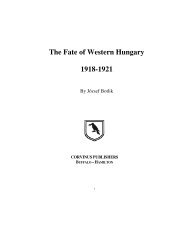The Tsangos of Romania - Corvinus Library - Hungarian History
The Tsangos of Romania - Corvinus Library - Hungarian History
The Tsangos of Romania - Corvinus Library - Hungarian History
You also want an ePaper? Increase the reach of your titles
YUMPU automatically turns print PDFs into web optimized ePapers that Google loves.
speak God`s truth.6. Chronology. Arranging the considered materials Ionly considered the principle <strong>of</strong> time, by putting the materials inchronological order. I kept only some <strong>of</strong> the publisheddocuments and even so I didn't use all the material available.That's true that in archives and manuscripts there exist manyother confessions. I reduced the number <strong>of</strong> the documents to theones, which no doubt are attesting the fact that our ancestors,the <strong>Hungarian</strong> catholics were living in many towns and villagesin Moldavia and their progeny are still living there.For the first trial, I limited myself to the period between themiddle <strong>of</strong> the XIIth century and beginning <strong>of</strong> the XIIIthcentury. My first source <strong>of</strong> collection was "ForeignTravellers About the Rumanian Countries", from whichI used the Rumanian translation <strong>of</strong> the texts, Latin, Italian,German or other in their origin. I didn't propose to refer to thewide literature <strong>of</strong> the subject, other works published in<strong>Hungarian</strong> and Rumanian. I used these only if they publishedsources about catholics from Moldavia from the certain period Iresearched. In all cases I indicated the source <strong>of</strong> the original textor the Rumanian translation. After the reference number <strong>of</strong> thedocument comes the editing date, then the name <strong>of</strong> the person,who filled in the document (if this is specified), the specification<strong>of</strong> the document (letter, report, registration, chronicle) and - incase - the name <strong>of</strong> the person or institution at destination. Insome <strong>of</strong> the cases we reproduced the original text <strong>of</strong> thedocument, in its original language, followed by [the Rumanian]translation. We used the same procedure, when the reportcontained significant information dealing with the subject.About the footnotes: we've limited them to the absolutenecessary explanations <strong>of</strong> the text.<strong>The</strong> study is followed by an index after the present names<strong>of</strong> localities and after their names used in the original texts. Wemention that we kept in the index only those locality names,which appear in the reproduced texts. From that results, the listdoes not contain all the Moldavian localities where the<strong>Hungarian</strong> Csango people were living in the past or where theyare still living now. In the attachment we tried to build up achronological list <strong>of</strong> the Catholic Bishoprics <strong>of</strong> the mentionedperiod. Next, we included a selective bibliography containingthe main documentary publications and studies, and twe usedthe shortened list.
















